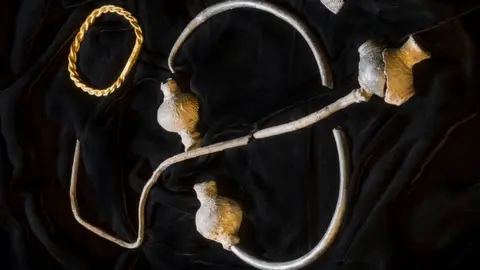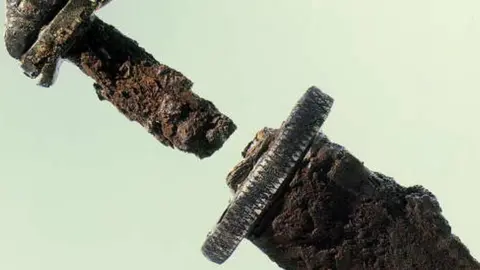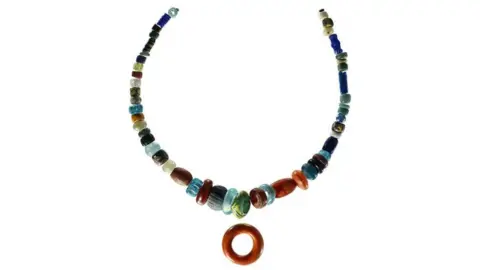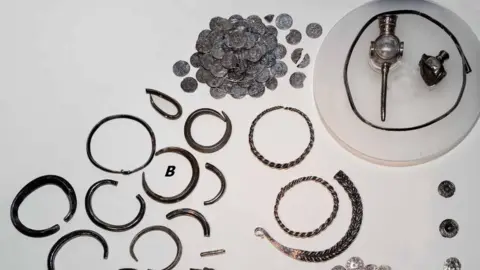Silver and swords: New light cast on the Isle of Man's Viking era
 MNH
MNHThe past year has seen a resurgence in interest in the Viking age on the Isle of Man after two significant finds were declared treasure.
The first was a collection of jewellery, which included a rare gold arm ring and large silver brooch, and the second was a Viking era "piggybank", containing hoard of 87 silver coins and 13 arm rings.
Two highly decorated brooches which were unearthed in 2018 also went on display for the first time.
Manx National Heritage's curator of archaeology Allison Fox said the ornate oval brooches were particularly significant, as it was previously only hypothesised that women had travelled to the island with their male Viking counterparts.
She said the brooches were the first find of their kind that provided proof women had also come from Scandinavia, filling in a "missing piece of the jigsaw puzzle" for the era.
 MNH
MNHVikings are thought to have arrived on the Isle of Man in the early 800s, first trading and then settling on the island.
Their time on the island spanned four centuries and their direct influence only ended in AD1266 when control was handed over to the King Alexander III of Scotland.
The island's location in the Irish Sea made it a useful hub for travellers, traders and seafarers alike and Viking items in the national collections range from fishing hooks and needles to swords and hoards of silver.
Ms Fox said evidence of their arrival had been found in a boat burial that was found at Balladoole, near Castletown, in the mid-1940s.
It was the grave of a male Viking and he was found buried in a ship of "local trading size", along with "everything he might need in the afterlife", although the absence of a sword has led to the assumption that he was a trader, she said.
 MNH
MNHHowever, she said a grave on the north of the island reflected a more "horrific" aspect of Viking burial practices.
She said it was significant not only due to the "content and the quality of the possessions" within it, but also because it contained a skull with a "massive slash to the back of the head".
The skull is believed to have belonged to a woman, who had been laid on a layer of cremated animals within the burial mound and was possibly the victim of a human sacrifice.
She said a shield, spearheads and what is "certainly the highest quality sword", which would have taken "an awful lot of work and quite a lot of money", were also found in the grave.
"As far as swords go, the Ballateare is high quality [for the island], but it's high quality compared to other places as well," she said.
 MNH
MNHHowever, perhaps the most well-known Viking-era burial on the island is that of the "Pagan Lady", found on St Patrick's Isle in Peel in 1984.
The burial, which has been dated to about AD950, had been incorporated into a Christian cemetery without disturbing any of the existing graves and contained a necklace made up of 51 colourful glass, jet and amber beads, some of which dated to the 6th Century.
Ms Fox said the necklace, along with other items found in the grave, suggested she had been a "really influential person in the community", though her identity remains a mystery.
It is not just graves that have shared their stories and their riches with the island though.
 MNH
MNHThere has been more Viking silver found on the Isle of Man per square kilometre than most other places in the British Isles and many of the larger finds date from about AD1,000 onwards, indicating that there was a lot of wealth on the island during the period.
The largest single discovery, known as the Ballaquayle hoard, was found in 1894 in Douglas and contained about 4.4lbs (2kg) of silver.
Ms Fox said the finds have not only enhanced understanding of Manx history, they also helped to create a clearer picture of the period elsewhere.
"Not everything that was found here was made here, so it generally fills the gaps in the knowledge of the Viking age everywhere really," she said.
Graves and silver though are not the most significant thing the Vikings left behind.
Their presence is still evident today in place names like Jurby and Snaefell, but their most notable influence is Tynwald, the parliament they founded during their rule of the island.
Its name derives from Old Norse, the language they used, and means the assembly's meeting place.
"The Vikings were responsible for introducing Tynwald," Ms Fox said.
"They decide how we go about life, what we can do and what we can't do.
"That's a pretty strong legacy."

Why not follow BBC Isle of Man on Facebook and Twitter? You can also send story ideas to [email protected]
